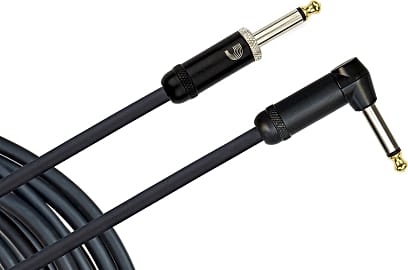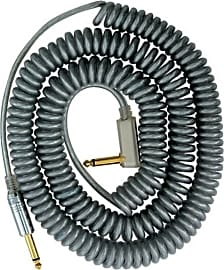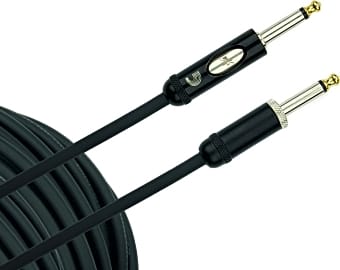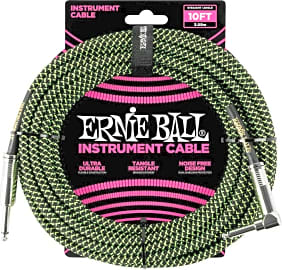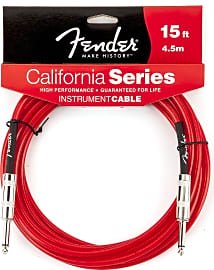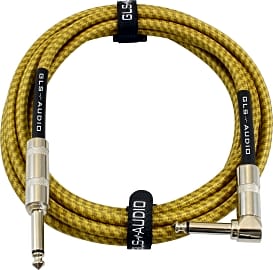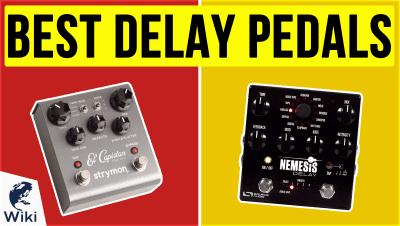The 10 Best Guitar Cables

This wiki has been updated 38 times since it was first published in October of 2016. Not all guitar cables are created equally. If you value your sound, take the time to find the right model that suits your requirements. Our comprehensive selection includes some with exceptionally low capacitance, along with those that have handy features like short-circuiting to help prevent the loud cracking noises that occur when you remove the connector from your output jack. When users buy our independently chosen editorial picks, we may earn commissions to help fund the Wiki.
Editor's Notes
October 28, 2020:
In the latest revision of our ranking, we updated the list to include two mid-range items produced by world-renowned makers of guitars and guitar-related products, namely Ernie Ball and Fender. These two companies were both founded in California in the middle of the twentieth century, and both have gone on to become highly successful in their own rights.
The Ernie Ball Right Angle has the added benefit of a 90-degree connector on one end, which, while seemingly a simple idea, can angle your cable away from effect pedals on a stage floor, and sits flush with a guitar's body when the output is on the front, as with a Gibson ES335, Gibson SG, and countless other classic models.
Alternatively, you could opt for the Fender California Series, with its straight connectors and high-quality cable. These are championed by gigging musicians for their sturdy construction, although those who prefer a lighter, more supple cable, might find these too stiff, and this can also be a minor inconvenience when shaking out coils as you set up your rig.
May 21, 2019:
While a high-end cable doesn't seem to outperform a mid-priced cable by all that much, the minute differences can make a world of difference to a professional. For a hobbyist, such differences may not be worth the added cost. For this reason, we've included a good mix of high-quality, budget-tier options, as well as premium models that occupy the upper echelon of the cost spectrum. Our #1 pick, the Kirlin IWB-202PFGL, for instance, isn't necessarily the absolute best cable in terms of performance, but when you factor in its low price, its cost-quality value earns it a spot at the top of the list.
The most expensive pick on our list sits rather low on the totem pole at #9. While it is a great cable, we felt that its shortcomings didn't justify its cost.
This updated ranking now includes the Vox VCC090, a vintage throwback, at #4. It's one of the most rugged cables available, and also one of the only reliable coiled options on the market. It occupies a sweet-spot in the cost hierarchy, situated perfectly between the cheapest and costliest cables. Those looking for something a step above the inexpensive GLS Audio, Rig Ninja, or the aforementioned Kirlin cable would be wise to look here, or to the uber-reliable Planet Waves American Stage, our #3 pick.
Special Honors
Revelation Cable Co. Specialists in all types of instrument cable, this Vancouver-based firm offers a wide variety of guitar cables in a range of configurations and sizes. These are incorporated in their custom shop, where you get to select your ideal length, cable, connectors, and color, and you can choose between regular and braided sheathing. revelationcablecompany.com
From The Axe To The Amp
So, it's no surprise that there are a variety of options available making a number of impressive claims about their superiority.
Since the dawn of the electric guitar, the cable has played a critical role. Throughout the annals of rock history, untangling huge nests of 1/4" cables after band practice has become a rite of passage for guitarists everywhere. So has the tradition of collecting these important items and lugging them around from basement to basement in search of the next jam. Wherever there's a lead, rhythm, or bass guitarist, there's sure to be a backpack full of cables nearby, especially if there are pedals involved.
The 1/4" guitar cable is ubiquitous throughout the audio industry. So, it's no surprise that there are a variety of options available making a number of impressive claims about their superiority. Connectors and conductors are made with precious metals and state-of-the-art construction methods. Manufacturers offer a multitude of reasons why their brand costs ten times the price of another, seemingly identical choice. These boasts can be legitimate, marginal, or downright misleading.
There's an entire camp of pragmatists who claim that a cable is just a cable. Of course, there's an equally convinced sect of purists who believe, sometimes in the face of patent evidence, that one cable sounds qualitatively and decisively better than another one that may share almost identical specifications.
Regardless of any subjective influences, there are definitely subtle differences in sound from product to product that are more important to audiophiles today than ever.
More Than Just A Copper Wire
There are certainly physical characteristics that affect the quality of a cable and the fidelity of the audio it transports. To understand how various cables differ, it first helps to have a rudimentary knowledge of cables themselves.
So, cranking up the volume when using a guitar cable to transport sound from an amp to a speaker may well result in the cable or connector melting or even combusting.
An instrument cable is unlike a lot of other audio or electrical cables. While traditional speaker cables do use an identical 1/4" plug type as guitar cables, they're actually built quite differently, with entirely separate capabilities. Rather than side-by-side positive and negative (or ground) wires transmitting a high-powered audio signal away from the amplifier, these specialized cables transmit a light current load through an insulated, conductive copper wire in the very center of the cable's construction. A braided sheath wrapped around that insulated wire acts as the ground wire. Interestingly, this means that the actual waves of current carrying the audio signal actually move down the plastic of the insulation itself while consistently maintaining the circuit between the inner and outer conductive materials.
This construction is ideal for moving a signal from a guitar to an amplifier. That's because the weak signal, which would normally be vulnerable to all kinds of interference, is protected as it runs inside of the grounded, braided shield. However, because of the relatively low conductivity of this shield, an instrument cable can't handle a very strong signal such as what would come out of an amplifier. So, cranking up the volume when using a guitar cable to transport sound from an amp to a speaker may well result in the cable or connector melting or even combusting.
Conversely, standard speaker cables as described above lack the extra shielding to protect the instrument's sensitive signal. For that reason, a speaker cable used as a go-between for a guitar and amp could easily end up buzzing and popping to the point of hurting music quality and damaging equipment.
Choosing The Right Guitar Cable
So, we've established how these surprisingly special cables work. Is there any real reason why some are vastly more expensive than others? A lot of enthusiasts will eagerly share how some of their most inexpensive cables outperform their pricey, brand-name units. While that does show that the most expensive option might not be the best one, it doesn't mean that prices and designations are totally arbitrary.
One basic fact to remember is that a cable cannot single-handedly add anything whatsoever to an audio signal. Conceptually speaking, the ideal instrument cable would have absolutely no effect on the analog signal moving through it. In practice, cables are involved in two processes that can change the timbre of what's fed into your amplifier.
A higher capacitance reduces the volume of the upper ranges of audio, making the rest of the spectrum more prominent in the mix.
Interference can alter the signal by adding static, pops, distortion, hums, and other noises. This occurs when a cable is poorly shielded or a connector is loose. A well-made unit will hold up over time, taking most of the everyday stretching force on its outside sheath and keeping the more sensitive inner conductor safe from damage. Because of its low elasticity and high flexibility, PVC has become the modern go-to for the most resilient cable.
Different cables also affect some of the higher frequencies in a guitar's signal at different rates. This happens according to a quality called capacitance, which is the conductor's ability to retain a portion of the analog signal it carries. A higher capacitance reduces the volume of the upper ranges of audio, making the rest of the spectrum more prominent in the mix. While this flies in the face of the ideal of a non-interfering guitar cable, it can have a dramatic effect in removing shrill or overly sharp tones from some guitars even before their sounds are processed by a pedal or amp.
At the end of the day, choosing the perfect guitar cable can take some first-hand research. Only you can determine which cable sounds best on your rig. Bass players might look for a coiled cable with more warmth, while lead soloists might opt to free up their treble with a brighter-sounding option. Of increasing popularity are solderless connectors, which allow savvy musicians to easily craft their own high-quality cables of custom length. Gold or silver-plated connections prevent corrosion in the long term. Some advanced models have switches that mute the signal when the adapter is unplugged, preventing pops when disconnecting instruments. Whichever route you take, make sure to choose a cable that's durable, because the best instrument cable is one you can rely on every gig.



